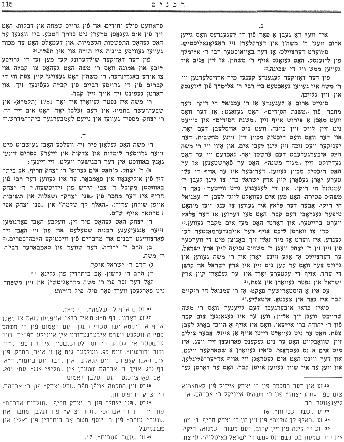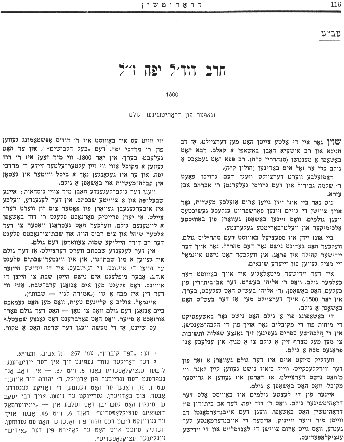Previous Page
|
Next Page

[
Page 115
]
3.
I would now like to discuss a few of the legends surrounding R. Moshe, and consider them to be realistic. The famous chassidic leader, Rabbi Elimelech of Lizhensk once said that R. Moshe's face shone like the Divine Presence. This legend indicates how highly R. Elimelech of Lizhensk and his colleagues respected R. Moshe.
There is also the legend that R. Emanuel Chai Riki, the author of Mishnat Chassidim said that whoever writes a commentary on his book that isn't in consonance with the ideas of R. Emanuel would not live out the year. However, whoever writes a commentary that is in consonance with the ideas of R. Emanuel would merit being buried next to him. Rabbi Moshe lived out the first year after he published Magid Mishnah, and thereby understood that his commentary was acceptable. In his old age R. Moshe moved to the Holy Land to die and be buried next to R. Emanuel Chai Riki. The legend goes on to say that after R. Moshe died, people wanted to bury him next to R. Emanuel, but the plot was too narrow. However, as they dug deeper, they found that the spot widened, and they were thus able to bury him there.
In order to clarify the foregoing legend, we should refer to the statement of R. Moshe's son, R. Yitzchak, regarding his father's trip to the Land of Israel. R. Yitzchak wrote that all his life his father regretted that he couldn't travel to the Holy Land and kiss the ground. In his old age, he did get there, and was buried in Safed. It is a historical fact that R. Emanuel Chai Riki's grave is in Zento, Italy.
It is worth mentioning what R. Moshe wrote about himself: when he went to the grave of the Talmudic sage, R. Yehudah son of R. Ilai, located on a high mountain near Safed, R. Moshe didn't want to ride a donkey. However, because he was weak, he couldn't find his way. Then a miracle occurred: like an eagle, a strong wind carried him to the gravesite, where he performed kabbalistic formulae and attained a great spiritual level. Tears started flowing, and he was able to transcend physicality, at which time he was able to perform certain kabbalistic formulae in his study of Torah and in his prayers.
This description shows the great love and faith that R. Moshe had for kabbalah and its masters. R. Moshe went to Safed where the graves of great rabbis are located, and where he was also buried. He died in 1781, and on the 17th of Tammuz of that year, his son R. Yitzchak eulogized him in the new synagogue in Lemberg.
4.
R. Moshe was survived by four sons who became acclaimed for their great erudition and righteousness, as well as for their books, which were known among the rabbis of the generation:
- R. Yitzchak, known as R. Yitzchak Charif, the head of the rabbinical court in Olyanov and Sambar. He was the teacher of the famous kabbalist, Rabbi Zvi Hirsh of Zidichov. R. Yitzchak Charif was the author of Pnei Yitzchak (rabbinical responsa on the Code of Jewish Law, Shulchan Aruch), Ha'Elef Lecha Shlomo, and Pnei Yitzchak Apei Zutra on the Talmud.
Yitzchak had four sons who served in rabbinical positions, and included rabbis and authors of important works on Jewish law.
- Rabbi Yehuda, the father-in-law of the Sambar rebbe, R. Moshe.
- Rabbi Yisrael Isser.
- Rabbi Gershon, the head of the rabbinical court in Glino.
the memory of R. Moshe of Drohitchin and his family never be forgotten for many many generations.

[
Page 116
]
EB”E
RABBI DAVIDEL YAFFE
1800
Creator of the Golem [a man-like speechless creature created by kabbalists] of Drohitchin
Even in distant past there were stories about how the Talmudic sages, Rabbi Chaninah and Rabbi Oshaya created a calf. Another sage, Rava, created a man (see tractate Sanhedrin, p. 65). Rav Papa created a golem to act as Rav Papa's servant (tractate Hulin, p. 105). This was also recounted in Spain about the great poet, Shlomo Ibn Gabirol and the great scholar, Avraham Ibn Ezra.
Not only did these stories about golems circulate among Jews, but circulated among gentiles as well. Such golems were said to have been created by alchemists and wise men. [The character of the Frankenstein monster was said to have been modeled on the idea of a Golem]
The most famous case of a Jewish golem was the one created by the rabbi known as the Maharal of Prague. This golem didn't only serve the Maharal, but also the entire Jewish community of Prague, which the golem saved several times from their enemies.
In Jewish legend there also existed the creature known as the Golem of Chelm, created by the head of the rabbinical court of Chelm, Rabbi Eliyahu, who lived approximately in 1500. It is also recounted that the Ba'al Shem Tov created a golem. The creation of golems was not thought of by kabbalists, but by halachic scholars as well. In Jewish law texts there is discussion of whether such a creature may be included in a prayer quorum (minyan) and other similar topics related to golems.
Therefore, the golem was part of reality, since there was no country where there weren't tales of great kabbalists creating them. One of the most recent golems was known as the Golem of Drohitchin, created by the head of the Drohitchin rabbinical court, Rabbi David Yaffe. We know very little about Rabbi Yaffe beyond the above legend that is known among Drohitchin émigrés and in the Jewish Encyclopedia.
As far as is known, Rabbi Yaffe was a descendant of Rabbi Mordechai Yaffe, the author of the book, Ba'al Halevushim, and he lived in approximately 1800. Rabbi David Yaffe was a kabbalist like his ancestor, R. Mordechai Yaffe, went a bit further, and became involved in practical kabbalah by creating a golem.
There are two versions of this golem legend: one is oral, and the other is in writing. The oral legend states that late every Friday afternoon, Rabbi David created a golem out of clay, which would bring water to the old synagogue and to the rabbi's house. At the end of the Sabbath, the rabbi would pronounce holy names in order to send away the golem.
The written legend records that the golem was a type of shabbos-goy [a non-Jew who agrees to perform actions on the Sabbath that Jews are prohibited to perform] that during the winter Sabbaths the golem would heat ovens in Jewish homes, etc. He wasn't asked to do this on the Sabbath itself, but prior to the Sabbath, in accordance with Jewish law pertaining to asking non-Jews to perform tasks prohibited to Jews on the Sabbath.
Due to a minor error that occurred when the golem was asked to perform a task that caused a fire that burned down the whole town.
The story about the fire has a source: there is a tradition in the family of
Previous Page
|
Next Page
This material is made available by JewishGen, Inc.
and the Yizkor Book Project for the purpose of
fulfilling our
mission of disseminating information about the Holocaust and
destroyed Jewish communities.
This material may not be copied,
sold or bartered without JewishGen, Inc.'s permission. Rights may be
reserved by the copyright holder.
JewishGen, Inc. makes no representations regarding the accuracy of
the translation. The reader may wish to refer to the original material
for verification.
JewishGen is not responsible for inaccuracies or omissions in the original work and cannot rewrite or edit the text to correct inaccuracies and/or omissions.
Our mission is to produce a translation of the original work and we cannot verify the accuracy of statements or alter facts cited.
 Drogichin, Belarus
Drogichin, Belarus
 Yizkor Book Project
Yizkor Book Project
 JewishGen Home Page
JewishGen Home Page
Yizkor Book Director, Lance Ackerfeld
This web page created by Lance Ackerfeld
Copyright © 1999-2025 by JewishGen, Inc.
Updated 10 Dec 2001 by LA

 Drogichin, Belarus
Drogichin, Belarus
 Yizkor Book Project
Yizkor Book Project
 JewishGen Home Page
JewishGen Home Page